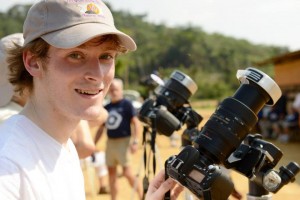By Laurel Hamers ’14
This week, the ScientEphic sat down with senior astrophysics major Allen Davis. He took some time out of his busy schedule to chat about his life as a globetrotting thesis student and a dedicated Trekkie.
LH: So, I’m sure you’ve been asked about this a lot, but what’s your thesis on? I’ve heard it’s involved a lot of travel.
AD: Yeah, the first part of my thesis is about the solar eclipse of November 3, 2013, which Jay Pasachoff (my advisor) and I viewed from Gabon!
LH: Can you tell me a little bit about your trip to Gabon?
AD: We were in Africa for a week. First we visited Lopé National park, where we went on safari to test our cameras. Then we went to a small remote village of about 40 people called Mikongo. From there, we set up our telescopes and cameras and waited for the eclipse to happen.
LH: Sure, you were “testing your cameras…”
AD: Well, we actually were! The goal in observing a solar eclipse is to study the solar corona—the hot gas that surrounds the sun. You can’t see it most of the time because of the sun’s glare, but when the moon covers the sun, it’s visible. We need to use a variety of exposure lengths to image the corona because the inside is much brighter than the outside, and then we piece these images together to get one unified picture. It’s important to fit all those images in within this window of about 59 seconds, which takes a lot of preparation. So a lot of my work involved programming sequences on the cameras and testing them extensively.
LH: Okay, okay. So what was it like to see the eclipse?
AD: The first exciting part is when you hold up your solar filter and see that the sun is beginning to be covered up by the moon. There’s a very small notch that gets cut out of the sun as the moon begins to overtake it, and that’s exciting because you know it’s the right place and the right time. And over the next hour, a bunch of interesting stuff happens.
LH: Like what?
AD: As the moon begins to cover up the sun, the illumination, of course, decreases, so you see everything get darker. But because of the way your vision works, you don’t really notice it until the last few minutes—those last little bits of sunlight are still enough to make everything visible. So for the last few minutes before totality, we saw what looked like a really fast sunset. There was this eerie light and all the shadows become much sharper. The goats were all crying out and the chickens and roosters were crowing.
Suddenly, in the last few seconds, you see what’s called the diamond ring, which is where the last little bead of sunlight is visible. And then you see this brilliant, tiny light source, and suddenly everything is gone. You look around and everything is dark. You can see stars and planets, but when you look up at the sun, you just see a black hole surrounded by these white rays.
LH: Wow! So how does that work into your thesis?
AD: Solar eclipses are rare enough phenomena that it’s really important to get good data when you have the opportunity. I got solid data of the eclipse that we’ll analyze for many years.
LH: You’ve been on a few other trips with the Astrophysics department, right?
AD: Yeah, the other part of my thesis deals with stellar occultations.
LH: Occultations?
AD: It’s what you call it when an object in the solar system moves in front of a distant object, like a star. I haven’t had a great deal of success in observing these events myself. The greatest challenge is prediction—there’s a great deal of precision that’s necessary, and lots of potential sources of error.
Last summer, for instance, I traveled to Santiago, Chile, to try to observe an occultation of a Kuiper belt object [the area of our solar system beyond the planets] called Quaoar. We went to Chile because we thought that was one of the areas where it might be visible. Turns out, it wasn’t. It was, however, visible from Venezuela. The astronomers in Venezuela did get good data, and I worked to analyze that. We were able to figure out a minimum size for Quaoar and its maximum possible density and reflectivity.
LH: How did you first get interested in astrophysics? And why did you choose to study it at Williams in particular?
AD: I attribute my interest in astronomy to Star Trek when I was young. Both of my parents were Trekkies, and so I was too from a very young age. Even when I was just a few months old I would perk up when I heard the star trek theme song. My mom went into labor with me while watching Star Trek! So Star Trek has long been a part of my life, and it made me want to explore space.
I looked at a number of colleges that had strong undergraduate astronomy programs, and I chose Williams because I really liked the liberal arts and the way that balanced with the strong physics and mathematics. I’ve loved those aspects of Williams, but also many more that I didn’t think about when I picked the school, like the entry system and the broader community.
Unfortunately, in this day and age, we’re not at the point where we can easily traverse interstellar distances and discover new alien races. So I’ve settled for being an astronomer, which has been great fun. It’s my way of exploring the universe as much as I can in this period of earth’s history.

